Photos of Special Events
|
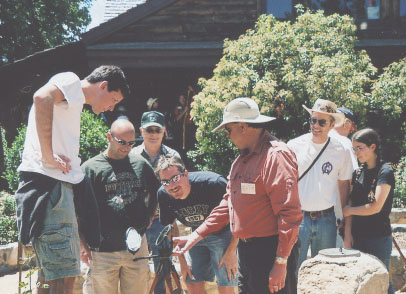
|
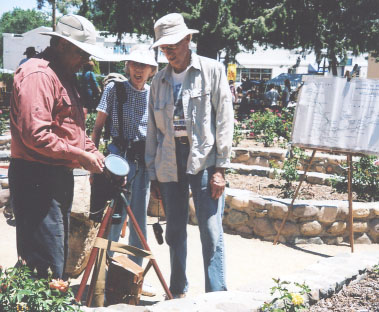
|
Dave
Selvidge, KE7FC, demonstrating his Mark
V heliograph at Sharlot Hall Museum during 2005 Folks Art Fair to a number
of interested folks. On a power pole, approximately 100 yards
distant, described below, can be seen a 4" white reflector, brilliantly illuminated by
the heliograph. Two mirrors are necessary for signalling this
targeted station as the sun is to the rear. Another sun-powered
device, a sundial is to the right. Also of interest is a window to
the right and above the bright spot to the right of the tree. The
spot is a reflection from a 2nd Hg (simplex) that can quickly be sighted
on a red reflector behind the window. |
Dave Selvidge, KE7FC, is
adjusting a single mirrored Heliograph, aligning it, a sight and the red
reflector behind the window. On the easel is a map of over 50 Hg stations
know to exist in 1890. When available, two Hg's are used for
signalling in opposite directions from a station to save several minutes in
resetting the Hg. |
|

|
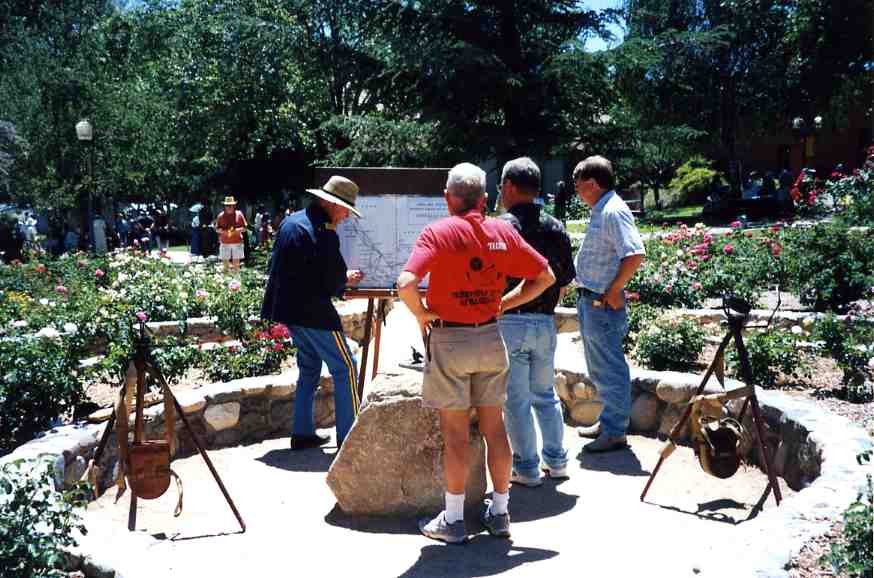
|
|
Charley Buehler, manning a Mark
V heliograph at Sharlot Hall Museum during 2004 Folks Art Fair. On
the power pole, at its intersection with the top rail of the chain link
fence, can be seen a 4" white reflector, brilliantly illuminated by
the heliograph. Two mirrors are necessary for signalling this
targeted station. |
Charley Buehler, a Living History presenter for the
Sharlot Hall Museum in Prescott, Arizona is pointing out Tubac, one of 28
heliograph stations manned by soldiers during the 1886 Geronimo
Campaign. The large rock is supporting a sundial, useful in describing yet
another way of harnessing the sun's power. Two Hg's are necessary for
signalling in opposite directions. |
|
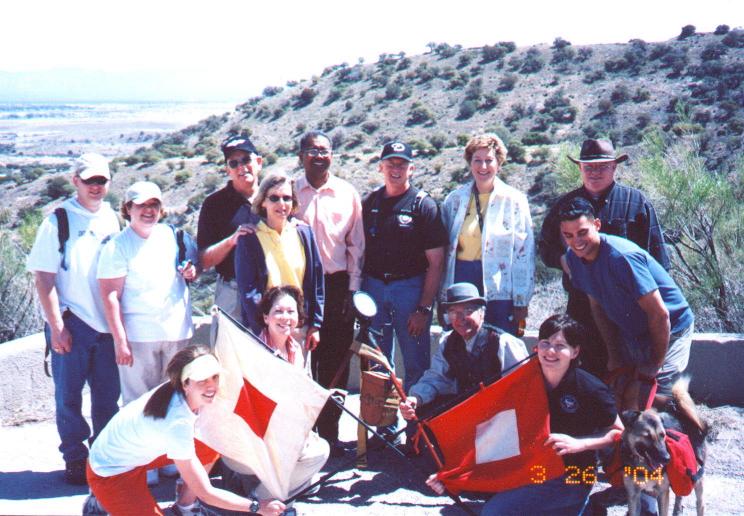
|
The March 26 2004 heliograph
demonstration at Fort Huachuca in southern Arizona was somewhat less than
brilliant for 36 mile distance signaling using a Mark V heliograph. As
I�ve said on too many occasions, �No sun, no fun�.
This wasn�t completely true because the we did enjoy learning
about the heliograph, and did have a reflector set up for practice, maybe
at eighty yards or so distant. I particularly want to thank Captain Indira
Donegan (squatting behind flag) for
her leadership and participation, one young lady with an unusual nickname
(holding same flag), and �Robert� (standing at extreme left) for their
assistance. Also,
Huachuca�s signal historian Vince Breslin (in cowboy hat) for organizing
the event. See "What's
New" for more information.
|
|

|
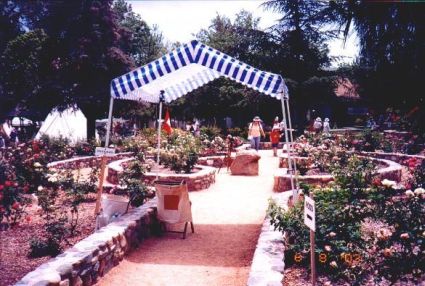
|
|
Mrs. Horn's Girl Scout Troop
learned about the heliograph during demonstration at the Sharlot Hall
Museum in Prescott, Arizona in June 2003. Understanding first the
sundial became a perfect lead-in, it harnessing the sun for telling time;
the heliograph doing the same for sending messages. Each
communicated using "code", Roman Numerals vs Morse. Note
the wigwag signal flag on left. We used a 4" white reflector on
a hill about 150 yds distant.
|
Setup for heliograph demonstration
in the Rose Garden of Sharlot Hall Museum in Prescott. Canopy
provided much needed shade while demonstrator, Jim Riddle, waited for
folks to stop by for a look-see. Note the other wigwag signal flag
on back of chair. 5 1/2" x 8 1/2" maps of the 1890
Heliograph System were given out. About 20 folks signed up for the
Hg e-mailing list. At least a couple of hundred people stopped by
for the demo.
|
|
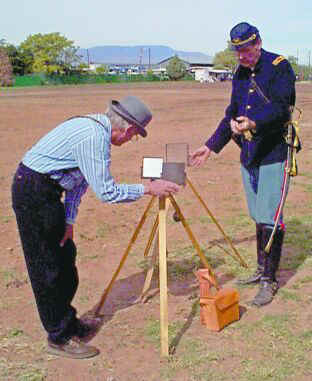
|
Fort Verde Days, October, 2002, drew
visitors and late-1800s re-enactors from around Arizona and out of state during the
weekend in Camp Verde. Family fun also included a carnival, a parade, other events,
and a wild horses and burros adoption through a special program by the federal Bureau of
Land Management. In the photo, re-enactors James Riddle of Prescott and Doug Howser
of Lancaster, California are working Doug's early 1900's US Marine Corps heliograph.
The U.S. Army used similar signaling equipment in the late 1800's to link Fort Verde, via
a two-mountain relay, with Fort Whipple near Prescott, Arizona. (Photo and
article are by permission from The Verde Independent -- Guinda Reeves, staff reporter.)
|
|
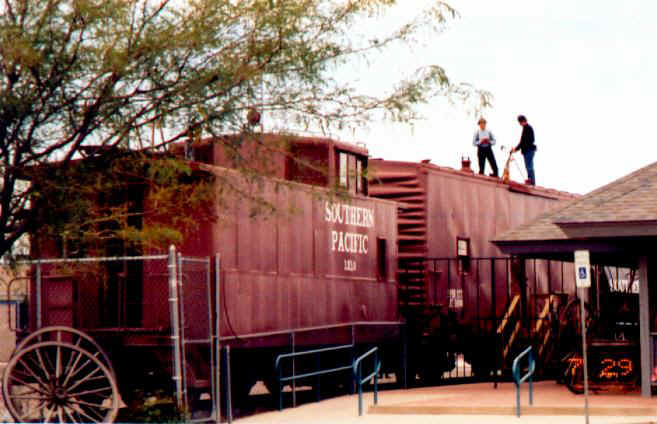
|
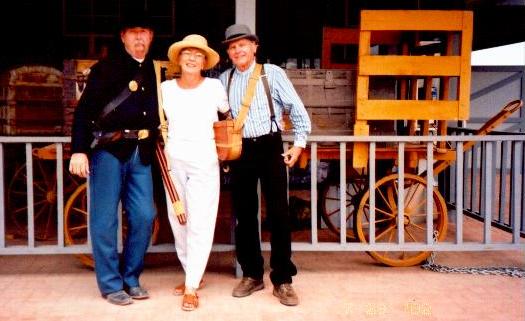
|
Would you believe that a railroad boxcar served as the
Deming, New Mexico heliograph station for the US Army in its campaign against Geronimo?
It is true, and thanks to the folks at Deming/Luna County Chamber of Commerce
we were able to resurrect the station for the day.
|
Trooper Ira Pinkstone, Cousin "Bink" Nelson and
myself, Jim Riddle. Photos in Deming and Fort Selden were taken July 29, 2002.
Other stations visited during the trip included Fort Huachuca, Henry Forrest,
Steins, and Fort Cummings.
|
|
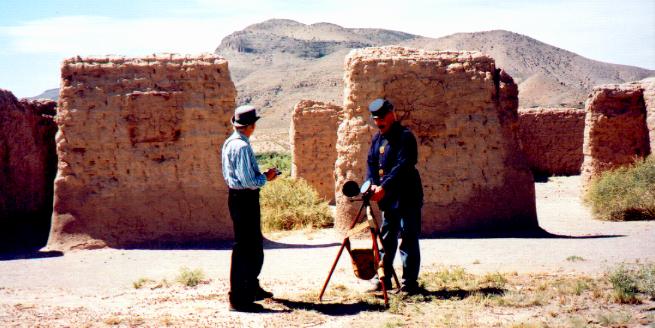
|
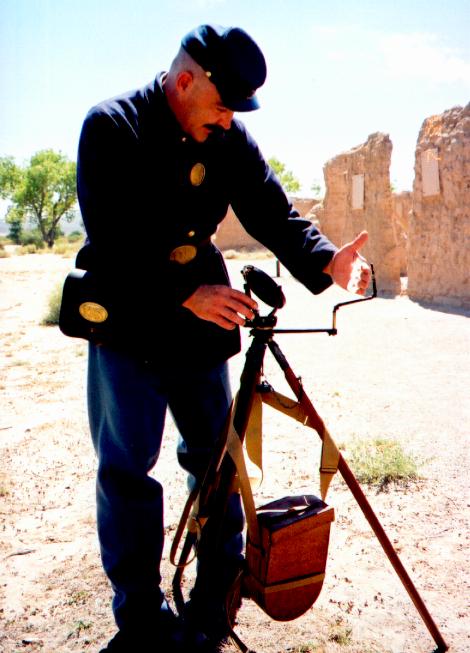
|
Jim Riddle and Nathan Stone communicating with hundred year
old "ghost" heliographers on "Lookout Peak" a few miles south of Fort
Selden. The fort, with its museum, is a popular attraction on the banks of the Rio
Grande River a few miles north of Las Cruces, New Mexico.
|
Trooper Nathan Stone, manager of Fort Selden State Park,
"capturing the shadow spot" as he aligns the Mark V heliograph on Lookout Peak.
|
|
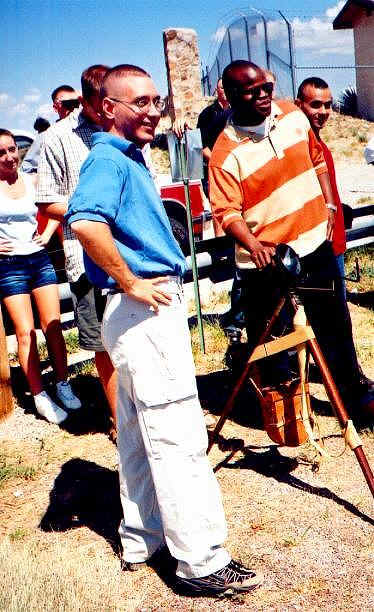
|
Why not a day off for a little fun and
frolic for these hi-tech soldiers trying out a 'hi-tech' heliograph (well, for the 1880s,
anyway) on Observation Hill at Fort Huachuca, Arizona? The hill was one of the 1886
heliograph sites used during the Army's Geronimo Campaign conducted by General Nelson
Miles.
The July 26 2002 Hg event followed four days of tough
competition by these signalmen soldiers brought in from around the world in their
competition for the coveted "Noncommissioned Officer and Soldier of the Year
Program" award.
After the demonstration, the soldiers, their spouses and
a couple of old white-headed heliographers, Ben Bryce and myself, all headed to Tombstone,
"The Town To Tough To Die". There we enjoyed lunch, a
"historama" on Tombstone, a re-enactment of the Battle of OK Corral, and a visit
to the old Cochise County Courthouse. Vince Breslin, the post's signal historian
orchestrated the day's activities. jhr
|
|
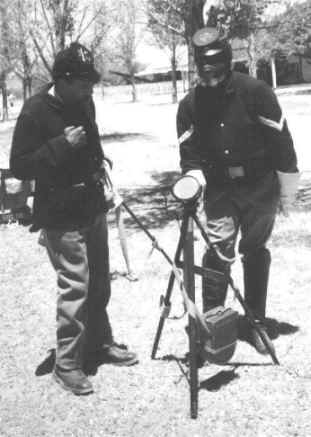
|
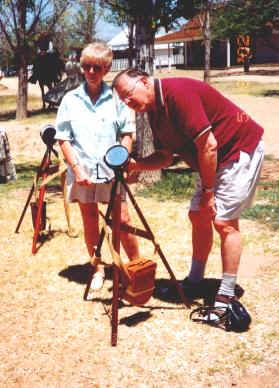
|
Trooper Roger Fair
and Sgt. Madison Walker, Trooper C, 10th Cavalry. These men represent Indian Wars'
"Buffalo Soldiers". Fort Verde "Armed Forces Day", May
18, 2002.
|
Mr. and
Mrs. Bill White of Prescott, Arizona trying out the heliograph on reflectors at Fort
Verde's "Armed Forces Day", May 18, 2002.
|
|
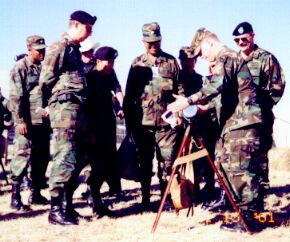
|
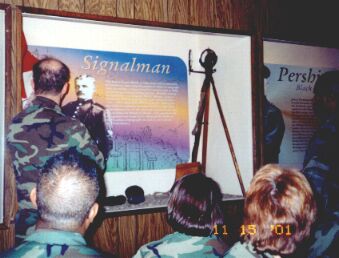
|
A demonstration was held by the author at Fort Huachuca on Nov 15, 2001. In this
photo the signaling soldier is "catching" the shadow spot. It is cast on
his hand by an unsilvered spot in the center of the heliograph mirror as he aligns the
instrument to place the spot in the exact center of the sighting vane. The same
procedure would apply if he were using a duplex mirror in place of the sight.
|
A Mance pattern heliograph is in a display case at the post's museum. To its left is
Will Barnes, a signalman who received the Congressional Medal of Honor at Fort Apache
while the fort was engaged in actions with hostile Apaches. Barnes used a flag to
signal the fort from a nearby mountain regarding hostile activities. The flag was
probably a wigwag. The heliograph was unknown to US signalmen at the time.
Barnes is better known for his books, "Arizona Place Names" and "Apaches
and Longhorns".
|
|

|
|
A photo of the post's group
taking part in the heliograph activities. Many of these men and women are reservists
who may possibly be seeing action in Afghanistan, a country not unfamiliar with the
heliograph. The non-soldiers are Vincent Breslin with the white hat who is the
post's signal historian, and the author kneeling next to a wigwag flag. The flag was
also demonstrated to the group.
|
|
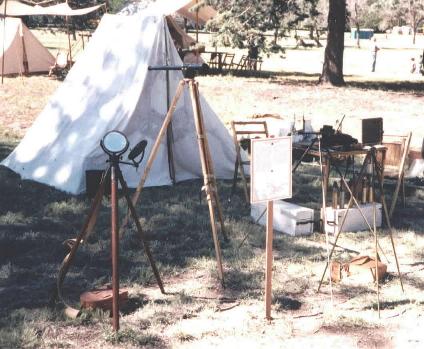
|
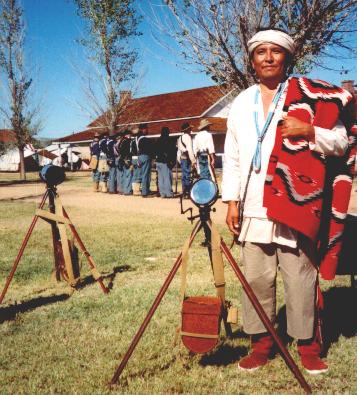
|
|
Doug
Howser's authentic reenactment encampment. Instruments left to right include a
Mark V Mance, a telescope, and an American type heliograph and screen, all mounted on
tripods.
|
No, it's not Geronimo surrendering at
Skeleton Canyon to General Miles, but rather it is No, it's not Geronimo surrendering at
Skeleton Canyon to General Miles, but rather it is John
Yazzi, a Navajo "Code Talker" from Kayenta. He is posed next to two
Mance Hg's at Fort Verde,
Arizona. The Mance on the left is setup for signaling to a target behind it, the
one on the right to a target in front of it. Both visible mirrors are directed
towards the sun. This was taken in front of an Officer's Quarters during Fort Verde
Days, October 2001.
|
|
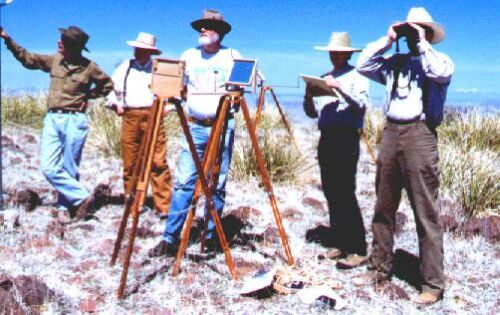
|

|
|
Part
of heliograph crew on Glassford Hill near Prescott, Arizona working Whipple Barracks in
March 2001. Note the second heliograph behind the mirror was used while working
Squaw Peak 30 miles east. Also note San Francisco Peaks to extreme right, about 63
miles distant which we hope to work. From left we have Fred Zimmermann, Tom Kosel
who constructed the heliographs pictured, Warren Miller of Sharlot Hall Museum, Dale
James, and Paul Smith who was in charge of the two Glassford stations.
Interestingly, Tom, Dale and Paul are all pharmacists.
|
Hg crew on Squaw Peak during
practice with Glassford Hill (Bald Mtn) in October, 2000. Pictured are Norm
Vandiver, Dave Luteyne, Roy Jackson, Jim Riddle, Tom Kosel and Jeanette Vandiver.
Range was 30 miles. That's a rock, not a dead goose, hanging from the Hg to steady
it in the wind. Didn't know it at the time, but the weight needs to barely touch the
ground to prevent it (and the Hg) from swinging. Interestingly, the crew on
Glassford Hill did not know Morse Code, but all was saved when their no-code ham copied
the alphabet from a radio transmission. Afterwards, they wrote down what they saw
when receiving, dots and dashes, and then translated them into letters. Same applied
when sending - while one member called out the dits and dahs for the letters the man on
the heliograph flashed what he heard. It worked well enough to get messages through!
|
|
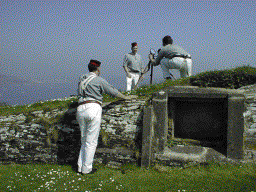
|
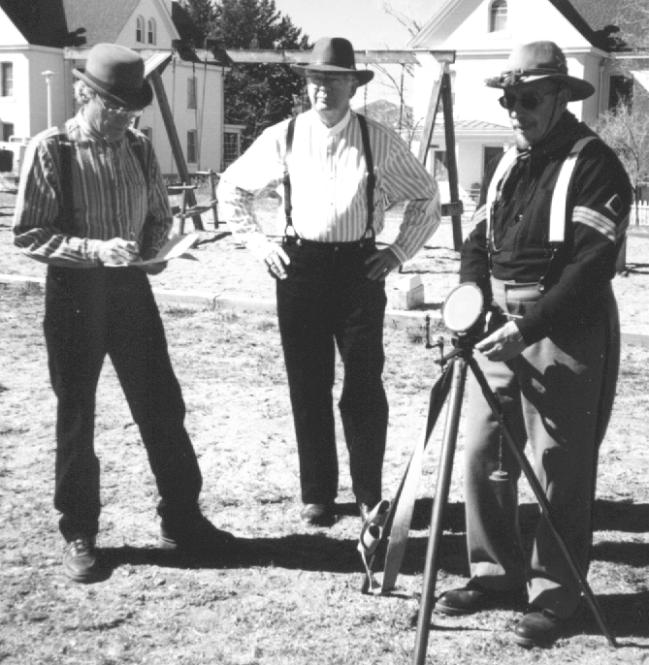
|
|
|
Jim Riddle, Fred Boughton
and Sgt. "Izzy" Ben-David at Whipple Barracks during taping for video production
for Arizona State Department of Energy training film. The Washington Signal Office
permitted wearing of civilian clothing for their signalmen when on temporary active duty
elsewhere (be sure and read von Hermann's article in "Related Sites")
|
|